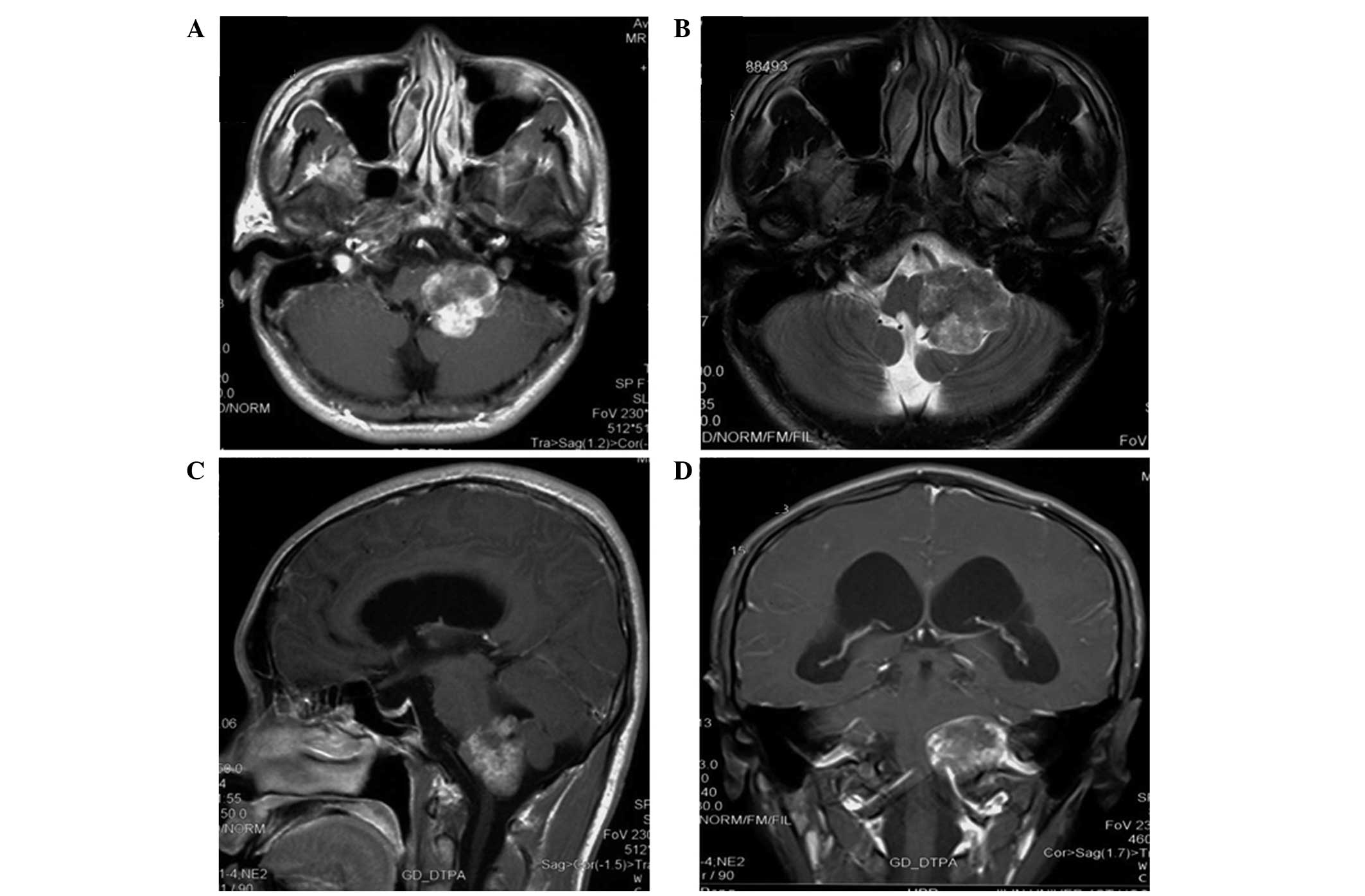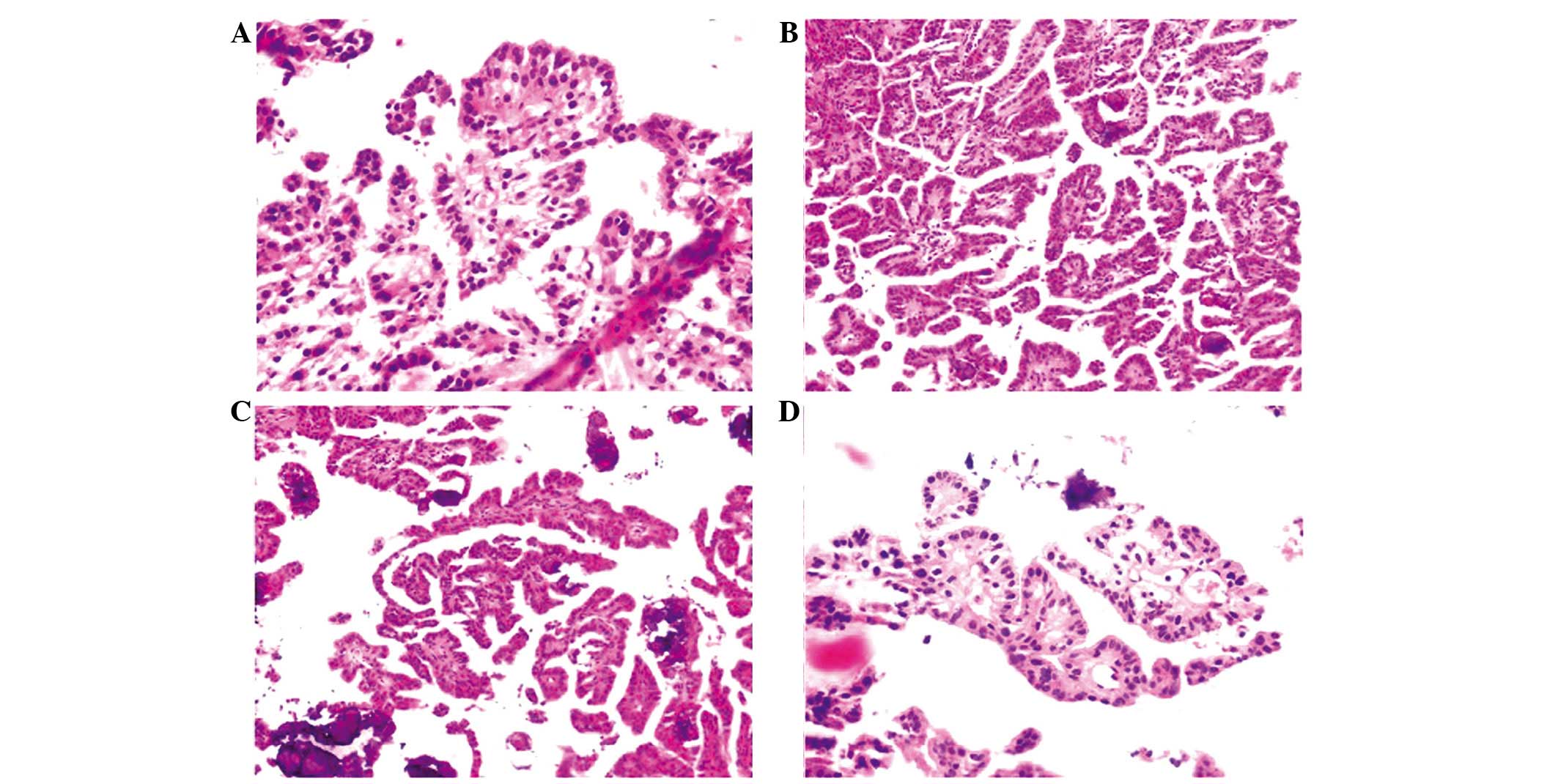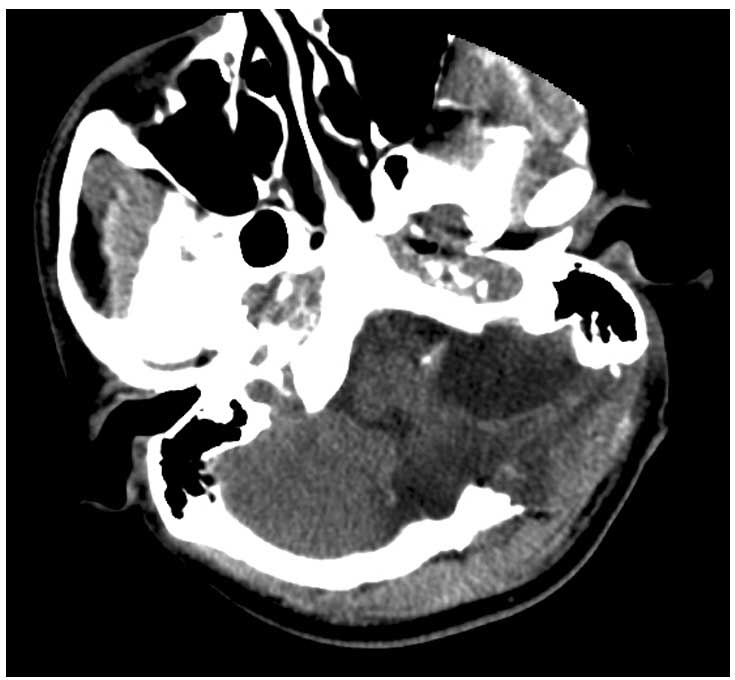Papillary meningioma of the jugular foramen: A case report
- Authors:
- Published online on: October 8, 2015 https://doi.org/10.3892/ol.2015.3785
- Pages: 3655-3659
Abstract
Introduction
The jugular foramen is the point of communication between the posterior fossa and the upper cervical vertebrae region (1), and tumors developed within this aperture lead to caudal cranial nerve lesions. The clinical presentation of jugular foramen tumors is variable, depending on the extent of involvement of the various cranial nerves (including nerves IX, X, XI and XII) (2). Glomus jugulare, paraganglioma and schwannoma are the most commonly diagnosed tumors in the jugular foramen (3). The occurrence of a primary meningioma within the jugular foramen is rare (4), particularly the occurrence of papillary meningioma (PM) within the jugular foramen. In 2004, Tabuse et al (5) reported the first case of jugular foramen PM (5).
Meningioma accounts for 24–30% of primary intracranial tumors diagnosed in the USA (6). The majority of meningiomas are benign, slow-growing tumors with a good prognosis. However, PM is an aggressive histological variant of meningioma, accounting for 1.0–2.5% of all the intracranial meningiomas diagnosed (7). According to the 2007 revision of the World Health Organization (WHO) tumor classification system (6), PM is pathologically identified as Grade III in cases where a perivascular or pseudopapillary pattern is present in the meningioma (8). The present study reported the case of an adult male patient who presented with paralysis of the cranial nerve XII and was diagnosed with a meningioma in the jugular foreman. The aim of the current study was to present the management of this rare entity and briefly provide its clinical, radiological and pathological characteristics, as well as to describe the surgical treatment strategy used and the outcome four years after surgery. This study was approved by the Ethics Committee of The First Hospital of Jilin University (Changchun, China) and written informed consent was obtained from the patient.
Case report
A 21 year-old male presented at the First Hospital of Jilin University (Changchun, China) in March 2010 with symptoms of headache and dizziness that had persisted for six months. A neurological examination revealed left hypoglossal nerve palsy and a left cerebellar sign (left-hand weakness). Computed tomography (CT) scans of the brain revealed a high-density mass in the left jugular foramen area, which was compressing inward onto the brainstem and the fourth brain ventricle. In addition, the bilateral and third brain ventricles were enlarged (Fig. 1A). A bone CT scan demonstrated expansion of the left jugular foramen and destruction of the adjacent bone (Fig. 1B). Furthermore, magnetic resonance imaging (MRI) scans of the brain identified a round, irregular signal (3.0×2.5×1.0 cm) in the left jugular foramen and verified the compression and enlargement patterns observed in the CT scans (Fig. 2A and B). Subsequent MRI scans using gadopentetate dimeglumine as a contrast agent demonstrated an enhanced irregular lesion (Fig. 2C and D).
The patient underwent a craniotomy for symptomatic improvement. Subsequently, complete surgical resection of the tumor was performed using a left far-lateral approach (9). During surgery, the tumor was identified to be attached to the dorsal part of the left petrous bone. The tumor-adjacent bone was evidently destroyed, and regions with the greatest extensive destruction were removed. Clear boundaries existed between the tumor and normal brain tissue, and the resection was conducted along these boundaries. The dural attachment was identified and coagulated; however, cranial nerves V and VII–XI were found to be intact.
The resected tumor was grey in color and 3.0×2.5×1.0 cm in size, and appeared to be solid and gritty. Microscopically, the tumor consisted of a monolayer of cells, which were arranged in a perivascular pseudorosette pattern surrounded by fibrous vessels with rich papillary growth. The papillary area was characterized by mitotic cells, regions of focal necrosis and eosinophilic cells with foamy nucleoli. Immunohistochemical staining (Fig. 3) revealed that the tumor cells were positive for galectin-3 and the epithelial membrane antigen. By contrast, immunostaining was negative for the primary adenoma (thyroid transcription factor-1 and cytokeratin 7), astrocyte (glial fibrillary acidic protein), thyroid cancer (thyroglobulin), meningioma (progestogen) and neuroendocrine tumor (synaptophysin) markers. However, immunostaining for the mesenchymal cell marker, vimentin, was inconclusive. These pathological findings identified the tumor to be a Grade III PM, according to the WHO classification.
The resection surgery was uneventful and no secondary symptoms emerged. CT scanning one day after surgery confirmed that the tumor had been completely resected. This was evidenced by the replacement of the high-density mass in the left jugular foramen area, which was present in the preoperative CT scan, with a hypo-density signal in the postoperative scan (Fig. 4). However, the patient continued to experience persistent headaches and dizziness, which were completely resolved 10 days after surgery. Within the four-year follow-up period following surgery, the cerebellar impairment and cranial nerve XII palsy were improved. However, the patient refused all recommendations for MRI examinations and further treatment due to personal reasons. A physical follow-up examination was performed in May 2012 and a telephone follow-up examination was conducted in February 2014, which revealed that the patient was well with no tumor recurrence.
Discussion
The present study reported a case of PM, which is a rare meningioma type, that was located within the jugular foramen. Complete tumor excision was performed without causing further neurological deficits. After four years of follow-up, no evidence of transformation or recurrence was identified.
Meningioma is a common intracranial neoplasm, accounting for 24–30% of primary intracranial tumors occurring in the USA (6). However, meningioma or PM arising from the jugular foramen are uncommon (8). Thus, only a limited number of PM cases in the jugular foramen have been reported in the literature. For instance, Wang et al (10) performed a large clinicopathologic study investigating 30 PM cases; however, no cases presented PM in the jugular foramen. To the best of our knowledge, the first case of jugular foramen PM was reported by Tabuse et al (5) in 2004.
Although PM is rare, it is a well-recognized histological variant of meningioma. The first reported case of PM was presented by Cushing and Eisenhardt in 1962 (11). A study reviewing 123 primary PMs revealed that PM tumor types were not gender-specific, but tended to occur in young adult patients with an average age of 35 years (12). In addition, 25% of the tumors assessed occurred in patients within the first two decades of their life, with a slightly increased incidence in females (female to male ratio, 3:2). Furthermore, Ludwin et al (13) identified that a relatively large proportion of PM cases in their study (8/17 patients) occurred in children, while Pasquier et al (14) reported seven cases of PM that occurred in patients between the ages of 21 and 69 years. In the population of the latter study, five of the tumors were supratentorial, one was located in the left temporal bone and one was located in the thoracic spinal canal (14). Thus, the supratentorial region was suggested to be a common location of PM. This observation was also confirmed by a further study by Wang et al (15), which reported 17 PM cases.
Regarding the clinical behavior of PM, the study by Ludwin et al (13) indicated that these tumors frequently display an aggressive clinical behavior, which is marked by a high rate of local recurrence and/or development of distant metastases. Jiang et al (16) reported a case of intraparenchymal PM of the brainstem. In addition, other studies have identified correlations between the clinical behavior of PM and certain clinical features. For instance, in a study of eight PM cases (17), two patients exhibited long-term survival without recurrence, two patients succumbed to the disease shortly after surgery, and four patients presented one or more recurrences and eventual PM-associated mortality. Those authors identified a correlation between ‘more malignant’ histological aspects and ‘more aggressive’ clinical behavior (17). Pasquier et al (14) also reached a similar conclusion, reporting that certain histological features (including necrosis, high mitotic index and rich peripapillary reticulin network) and tumor evolutionary events (such as high rate of local recurrence or development of distant metastases) were correlated and may represent a histological link between syncytial, fibroblastic and hemangiopericytic meningiomas.
PM is generally associated with a high mortality rate. Wang et al (15) reported that the 3-year mortality rate for PM was 50% after gross total resection and 63.6% for other cases. A previous study concluded that the majority of PM cases reported in the literature are aggressive variants of meningioma, with frequent local recurrence, dissemination in the cerebral spinal fluid and metastases to remote sites (18). In addition, local recurrence of PM has been reported in 56.5% of cases, which is significantly higher compared with the 10–20% recurrence rate reported for conventional meningiomas (19). Furthermore, the aggressive behavior of PM associated with morbidity and mortality warrants a timely recognition of the diagnosis (20).
A genetic study has also been conducted in PM patients, by Weber et al (21), in which a comparative genomic hybridization screening for genomic imbalances was performed in benign, atypical and anaplastic sporadic meningiomas. The authors identified that accumulation of genomic aberrations occurred in parallel with increasing malignancy grade. Thus, genetic profiles of meningiomas were proposed corresponding to tumors with varying degrees of malignancy.
Considering the frequent malignant behavior of PM, radical surgical intervention is the routine treatment strategy. However, surgical manipulation of the jugular foramen region is challenging (22). Although the treatment of choice for meningiomas is complete resection, this may not be feasible for jugular foramen PM. The principal aim of surgical treatment is to improve survival, while a secondary objective is to return the function of caudal cranial nerves (23). Therefore, the development of a PM management strategy that is noninvasive/nonsurgical is crucial. A previous study has evaluated the efficacy of radiotherapy or chemotherapy, but reported inconclusive findings (5). Due to the rarity of PMs, no clear consensus exists regarding the appropriate management of the disease. However, the combination of aggressive surgical resection and postoperative radiotherapy has emerged as a standard treatment strategy for PM (16,23). For patients with asymptomatic recurrence or high-risk surgical cases, stereotactic radiosurgery may be a useful alternative. Mattozo et al (24) analyzed the efficacy of a stereotactic radiation treatment strategy in patients with recurrent nonbenign meningiomas. The results indicated that stereotactic radiation treatment provided effective local control of ‘aggressive’ Grade I and II meningiomas; however, Grade III lesions maintained a poor outcome. (24). Therefore, it is critical to perform careful and long-term follow-up of patients due to the malignant and aggressive behavior of this rare tumor. However, in the current study, no further MRI scans were performed following the decision of the patient, who did not present any physical complaints during the postoperative follow-up period.
In conclusion, the present study reported a case of jugular foramen PM in a young adult who presented with persistent headaches and dizziness. The definitive diagnosis of PM relied on histopathological findings. PM is a rare disease, particularly in the jugular foramen area. Therefore, careful clinical care and follow-up should be provided to manage this rare meningioma considering its malignant and aggressive behavior.
References
|
Roche PH, Mercier P, Sameshima T and Fournier HD: Surgical anatomy of the jugular foramen. Adv Tech Stand Neurosurg. 33:233–263. 2008. View Article : Google Scholar : PubMed/NCBI | |
|
Samii M, Babu RP, Tatagiba M and Sepehrnia A: Surgical treatment of jugular foramen schwannomas. J Neurosurg. 82:924–932. 1995. View Article : Google Scholar : PubMed/NCBI | |
|
Gilbert ME, Shelton C, McDonald A, et al: Meningioma of the jugular foramen: glomus jugulare mimic and surgical challenge. Laryngoscope. 114:25–32. 2004. View Article : Google Scholar : PubMed/NCBI | |
|
Ramina R, Neto MC, Fernandes YB, Aguiar PH, de Meneses MS and Torres LF: Meningiomas of the jugular foramen. Neurosurg Rev. 29:55–60. 2006. View Article : Google Scholar : PubMed/NCBI | |
|
Tabuse M, Uchida K, Ueda R, Ikeda E and Kawase T: Jugular foramen papillary meningioma: a case report. Brain Tumor Pathol. 21:143–147. 2004. View Article : Google Scholar : PubMed/NCBI | |
|
Louis DN, Ohgaki H, Wiestler OD, et al: The 2007 WHO classification of tumours of the central nervous system. Acta Neuropathol. 14:97–109. 2007. View Article : Google Scholar | |
|
Enam SA, Abdulrauf S, Mehta B, Malik GM and Mahmood A: Metastasis in meningioma. Acta Neurochir (Wien). 138:1172–1177. 1996. View Article : Google Scholar : PubMed/NCBI | |
|
Buccoliero AM, Caldarella A, Taddei A, et al: Atypical, aplastic and unusual meningiomas. Morphology and incidence in 300 consecutive cases. Pathologica. 95:83–87. 2003.(In Italian). PubMed/NCBI | |
|
Flores BC, Boudreaux BP, Klinger DR, Mickey BE and Barnett SL: The far-lateral approach for foramen magnum meningiomas. Neurosurg Focus. 35:E122013. View Article : Google Scholar : PubMed/NCBI | |
|
Wang XQ, Chen H, Zhao L, et al: Intracranial papillary meningioma: a clinicopathologic study of 30 cases at a single institution. Neurosurgery. 73:777–790. 2013. View Article : Google Scholar : PubMed/NCBI | |
|
Cushing H and Eisenhardt L: Meningiomas: their classification, regional behaviour, life history, and surgical end results. New York: Hafner Publishing Co. 199–207. 1962. | |
|
Shuangshoti S: Primary papillary meningioma of the optic nerve sheath: a case of unique location and benign pathology. Surg Neurol. 39:200–203. 1993. View Article : Google Scholar : PubMed/NCBI | |
|
Ludwin SK, Rubinstein LJ and Russell DS: Papillary meningioma: a malignant variant of meningioma. Cancer. 36:1363–1373. 1975. View Article : Google Scholar : PubMed/NCBI | |
|
Pasquier B, Gasnier F, Pasquier D, Keddari E, Morens A and Couderc P: Papillary meningioma. Clinicopathologic study of seven cases and review of the literature. Cancer. 58:299–305. 1986. View Article : Google Scholar : PubMed/NCBI | |
|
Wang DJ, Zheng MZ, Gong Y, et al: Papillary meningioma: clinical and histopathological observations. Int J Clin Exp Pathol. 6:878–888. 2013.PubMed/NCBI | |
|
Jiang XB, Ke C, Han ZA, et al: Intraparenchymal papillary meningioma of brainstem: case report and literature review. World J Surg Oncol. 10:102012. View Article : Google Scholar : PubMed/NCBI | |
|
Brignolio F and Favero M: Considerations on the malignancy of papillary meningioma. Clinico-pathological study of eight cases. Zentralbl Neurochir. 45:79–84. 1984.PubMed/NCBI | |
|
Meinsma-vdTuin M, Molenaar WM and Mooij JJ: Spinal papillary meningioma: a case report and review of the literature. Acta Neurochir (Wien). 142:703–708. 2000. View Article : Google Scholar : PubMed/NCBI | |
|
Thomas C and Leonetti JP: Papillary (malignant) meningioma of the foramen magnum presenting as a posterior neck mass. Skull Base Surg. 4:164–168. 1994. View Article : Google Scholar : PubMed/NCBI | |
|
Jairajpuri Z, Jain I and Singh A: Papillary meningioma: a rare malignant variant. Indian J Pathol Microbiol. 54:410–411. 2011. View Article : Google Scholar : PubMed/NCBI | |
|
Weber RG, Boström J, Wolter M, et al: Analysis of genomic alterations in benign, atypical, and anaplastic meningiomas: toward a genetic model of meningioma progression. Proc Natl Acad Sci USA. 94:14719–14724. 1997. View Article : Google Scholar : PubMed/NCBI | |
|
Tekkök IH, Ozcan OE, Turan E and Onol B: Jugular foramen meningioma. Report of a case and review of the literature. J Neurosurg Sci. 41:283–292. 1997.PubMed/NCBI | |
|
Hanft S, Canoll P and Bruce JN: A review of malignant meningiomas: diagnosis, characteristics, and treatment. J Neurooncol. 99:433–443. 2010. View Article : Google Scholar : PubMed/NCBI | |
|
Mattozo CA, De Salles AA, Klement IA, et al: Stereotactic radiation treatment for recurrent nonbenign meningiomas. J Neurosurg. 106:846–854. 2007. View Article : Google Scholar : PubMed/NCBI |













